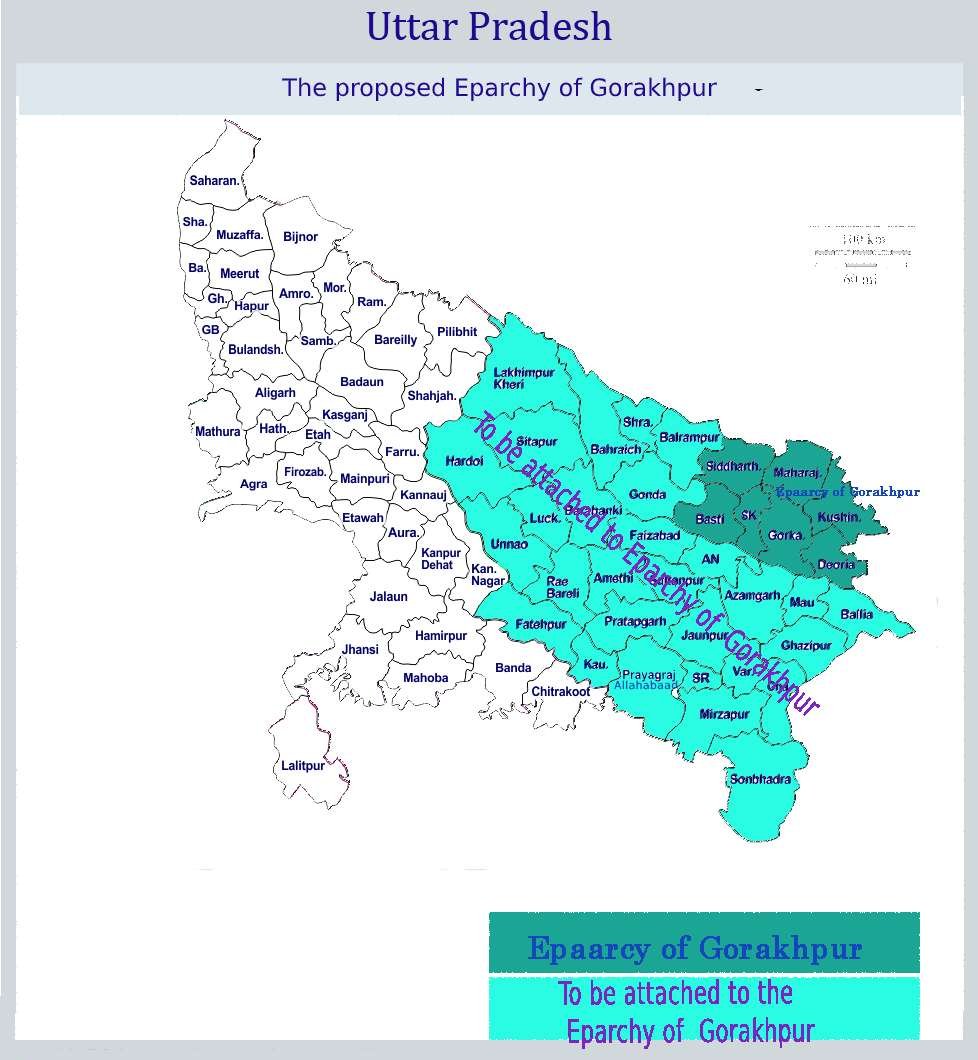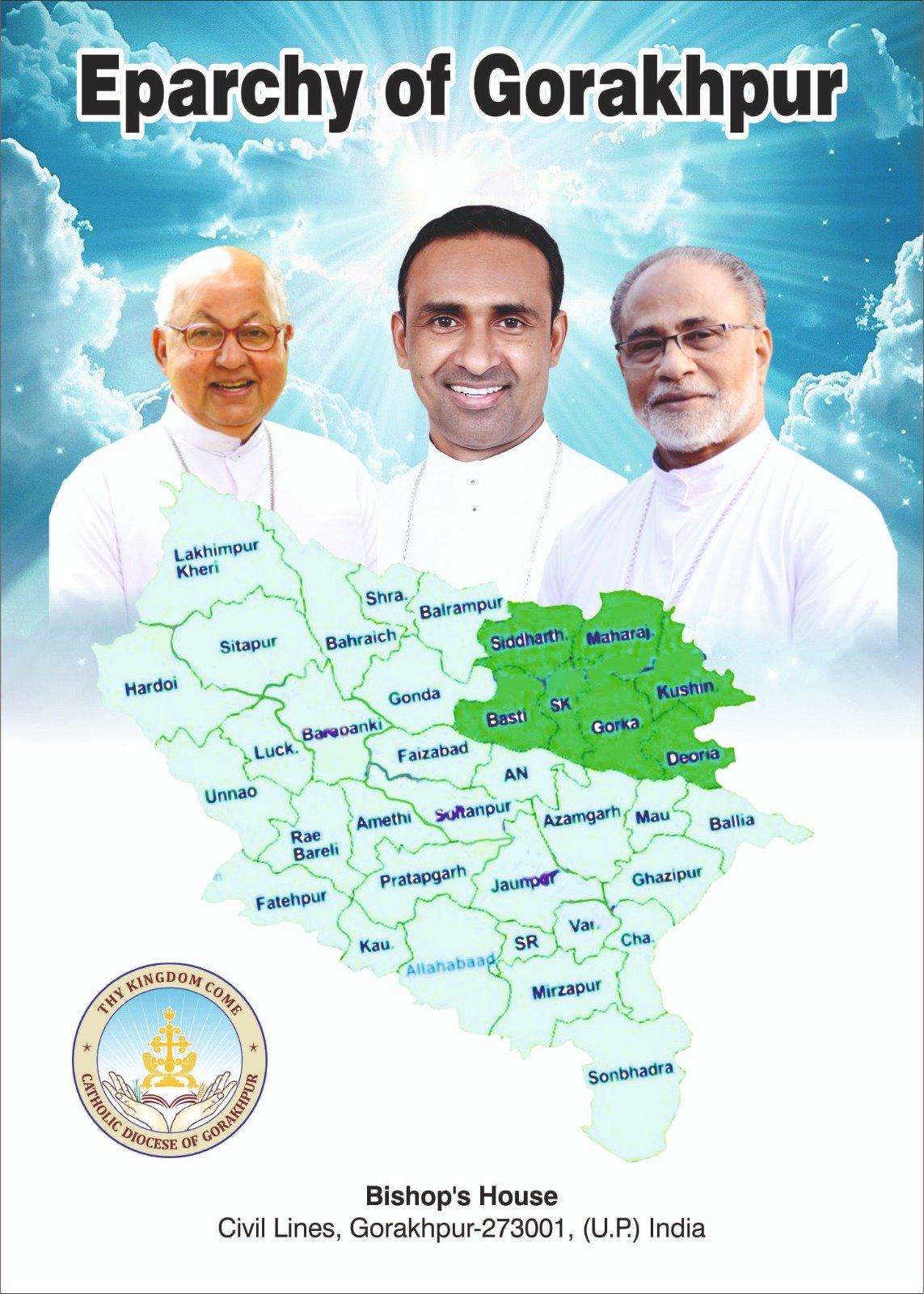A brief history of the Diocese of Gorakhpur
The Catholic Eparchy of Gorakhpur was erected on the 19th June 1984 by His Holiness Pope John Paul II through the Bull 'Ex quo Divinum Concilium'. Rev. Fr. Dominic Kokkat CST was appointed its first Bishop. It comprises of seven north eastern districts of the state of Uttar Pradesh viz. Gorakhpur, Deoria, Sant Kabirnagar, Basti, Kushinagar, Maharajganj and Siddharthnagar covering an area of 19070 sq. km. It has a population of about 17.1 million, of which the Catholics number only 3400. The languages spoken in this part of the Gangetic plain are Hindi and Bhojpuri. It is situated 750 kms. South East of Delhi, 225 kms. North of Varanasi and 275 kms. West of Lucknow, the capital city of the state of Uttar Pradesh.
This Eparchy is the fruitful outcome of the silent and long perseverance of the catholic faithful and their spiritual leaders both in the past and present. Although the Christian origin in Gorakhpur is longer and more distant, the Catholic Christian origin in Gorakhpur could be traced back to a group of native Catholics from the then Bethiaraj who migrated to this city as agricultural labourers in the beginning of 1800 during the British colonialism. However, the Handbook of Bengal Mission mentions about the Roman Catholic mission undertaken by Fr. Joseph Maria around 1740 and some Italian missionaries under the guidance of the Vicar Apostolic of Patna appeared to have rendered pastoral assistance in Gorakhpur When Fr. Raphel of Livorno was appointed chaplain in Gorakhpur, he built St. Joseph's Church, now the Cathedral, in 1860. In 1886 Gorakhpur became part of the Diocese of Allahabad.
By 1906 Gorakhpur became the headquarters of various mission outstations, thanks to the works done by Fr. Joseph Hiki and Fr. T. Considine between 1892 to 1906. Gorakhpur-Banaras prefecture was erected in the year 1947 and was entrusted to the dynamic leadership of late venerable Msgr. Jerome Malenfant Ofm. Cap. In 1958, the Headquarters of the Prefecture was shifted to Varanasi. In 1967, the Gorakhpur-Banaras Prefecture got its name changed into Banaras-Gorakhpur Prefecture. In 1970, this Prefecture became the Diocese of Varanasi. Late Venerable Fr. Basilius Panat CST, the founder of the Little Flower Congregation, at the invitation of Msgr. Malenfant Ofm. Cap., visited this mission and worked out the modalities for sending his priests to begin the pastoral and evangelical activities in Gorakhpur in 1969-70. Since 1970 the CST fathers were actively involved in the Evangelical works in this prefecture which became the diocese of Varanasi in the same year. Next fourteen years saw progressive efforts resulting in the emergence of Gorakhpur as an Eparchy. Taking into consideration the problems typical to this vast area, the Eparchy has worked out pastoral, ecumenical, Inter religious, educational, rural developmental and health care apostolates.
The Eparchy has, today, 59 Eparchial priests, 2 religious priests, 7 religious brothers and 205 sisters to carry out the mission entrusted to it with the active involvement and support of the laity.
Priests & religious at a glance
Parishes at a glance

Parishes

DEANERIES

Semi-Parishes & Mission Stations
The growth of the Diocese in the past 41 years
| 01 | Parishes | 03 | |
| 02 | Semi-Parishes/Mission Stations | 30 | |
| 03 | Mission Sub-Stations | 02 | |
| 04 | Catholics | 3400 | |
| 05 | Diocesan Priests | 59 | |
| 06 | Religious | Priests | 25 |
| Brothers | 07 | ||
| Women | 205 | ||
| 07 | Convents | 44 | |
| 08 | Novitiate House | 01 | |
| 09 | Minor Seminaries | Diocesan | 01 |
| Religious | 01 | ||
| 10 | Primary Schools | 03 | |
| 11 | Junior High Schools | 03 | |
| 12 | High Schools | 11 | |
| 13 | Senior Secondary School | 23 | |
| 14 | College for women | 01 | |
| 15 | Referral Hospital | 02 | |
| 16 | Maternity Clinics/Dispensaries/ Health Centers/Eye Clinics | 08 | |
| 17 | Rehabilitation Center for Handicapped Children | 01 | |
| 18 | Rehabilitation Center for Mentally challenged children | 01 | |
| 19 | Home for the Poor and Dying Destitute | 03 | |
| 20 | Boarding for Boys | 02 | |
| 21 | Boarding for Girls | 03 | |
| 22 | Vocational Training Centers | 01 | |
| 23 | Printing and Training Centre | 01 | |
| 24 | Media and Communication | 01 | |
| 25 | Psycho-spiritual center | 01 | |









